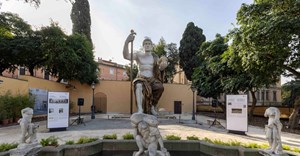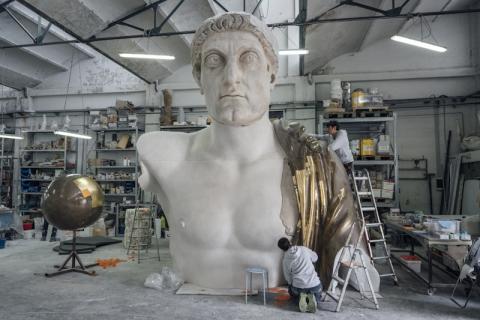
The statue, is approximately in height 13 metres and was created using an innovative reconstruction process, starting with the original pieces from the 4th century A.D. preserved in the Musei Capitolini.
At approximately 13 metres in height, the colossal statue of Costantino (4th century A.D.) is one of the most significant examples of late antique Roman sculpture. Of the entire statue, rediscovered in the 15th century at the Basilica di Massenzio, today only a few monumental marble fragments remain, housed in the courtyard of the Palazzo dei Conservatori at the Musei Capitolini: head, right arm, wrist, right hand, right knee, right shin, right foot, left foot.
From 6 February 2024 it is possible in the garden of Villa Caffarelli to enjoy the extraordinary 1:1 scale reconstruction of the Colosso in all its impressive dimensions. The artwork was presented for the first time in Milano from 17 November 2022 to 27 February 2023, during the exhibition Recycling Beauty curated by Salvatore Settis and Anna Anguissola with Denise La Monica.
The Giardino di Villa Caffarelli, where the reproduction of the Colosso di Costantino has been placed, lies partly on the area occupied by the Tempio di Giove Ottimo Massimo, that once hosted the statue of Giove, the same statue from which the Colosso was perhaps obtained or that in any case constitutes the model of its derivation. The remains of the temple are visible today inside the Esedra of Marco Aurelio.
The project for the reconstruction of the giant statue of Costantino was based on important archaeological, historical and functional analysis of the pieces, supported by the reading of literary and epigraphic sources.
The nine fragments in Parian marble, now preserved in the Musei Capitolini, were found in 1486 inside the apse of a building that at the time was believed to the Tempio della Pace di Vespasiano, and that only in the early 19th century would be correctly identified with the Basilica di Massenzio along the Via Sacra. They were thought to belong to a statue of the emperor Commodo and, due to their exceptional importance, were set up in the Palazzo dei Conservatori during the renovation of the same, carried out to a design by Michelangelo between 1567 and 1569. The fragments were only identified as a colossal portrait of the emperor Constantino in the late 19th century.
A tenth fragment, part of the thorax, found in 1951, is about to be transferred from the Parco Archeologico del Colosseo to the courtyard of the Palazzo dei Conservatori, next to the other fragments. The archaeological study of the fragments has allowed us to hypothesise that the Colosso was seated and that it was made as an acrolith, that is to say with the naked parts in white marble and the drapery in metal or gilded stucco. According to an iconographic scheme typical of the time, which likened the emperor to a divinity, Costantino is represented as Giove with the upper part of his body uncovered and his cloak resting on his shoulder; his right arm holding the sceptre with a long shaft and his left hand holding the globe.

Factum Foundation re-creating the Colossus of Constantine, 2022. Copyright Oak Tyler-Smith
At the end of March 2022, a team from the Factum Foundation spent three days in the courtyard of the Musei Capitolini to scan the fragments present using the technique of photogrammetry. Each fragment was modelled in 3D and positioned on the digital body of the statue created using other cult statues from the imperial age in similar poses as iconographic examples, including the colossal statue of Giove (1st century AD) in the Museo statale Ermitage in San Pietroburgo, probably inspired by the Zeus di Olimpia by Fidia, and the large plaster copy of the statue of the emperor Claudio, portrayed as Giove, in the Ara Pacis Museum.
The reconstruction process carried out by Factum took into account many factors: the type of marble of the original parts, the restorations and additions; the details of the missing drapery and the appearance of the gilded bronze of which it was composed; the relationship between the reconstruction and the surviving fragments, the condition of these and their exact location. After finalising the very high resolution 3D model, the material reconstruction of the Colosso was then carried out. Resin and polyurethane, combined with marble powder, gold leaf and plaster, were chosen as materials to render the material surfaces of the marble and bronze, while an easily assembled and removable aluminium support was used for the internal structure (originally perhaps composed of bricks, wood and metal bars).
The final result allows one to admire, in a magnificent illusion, the Colosso as a whole, in which one can visually distinguish the "stitching" between the rematerialised parts and the copies of the original fragments in the courtyard of the Palazzo dei Conservatori.

ArtDependence Magazine is an international magazine covering all spheres of contemporary art, as well as modern and classical art.
ArtDependence features the latest art news, highlighting interviews with today’s most influential artists, galleries, curators, collectors, fair directors and individuals at the axis of the arts.
The magazine also covers series of articles and reviews on critical art events, new publications and other foremost happenings in the art world.
If you would like to submit events or editorial content to ArtDependence Magazine, please feel free to reach the magazine via the contact page.